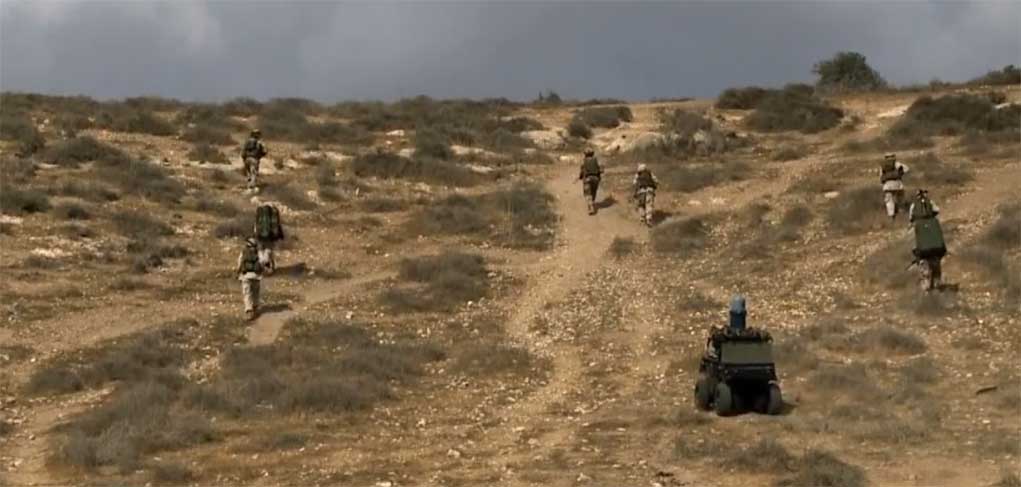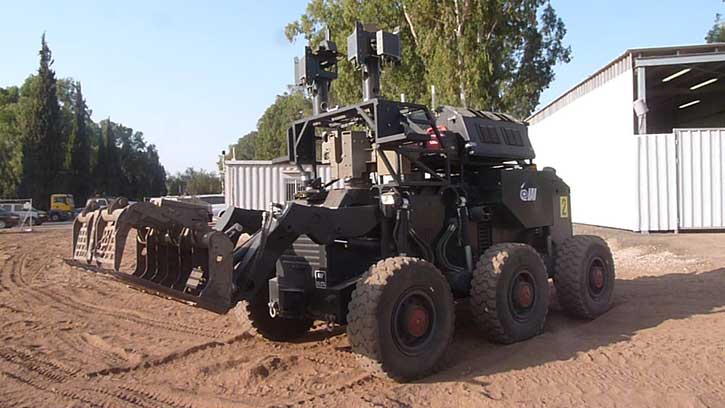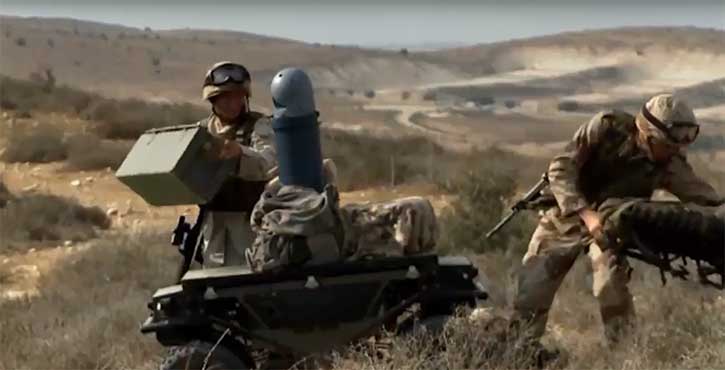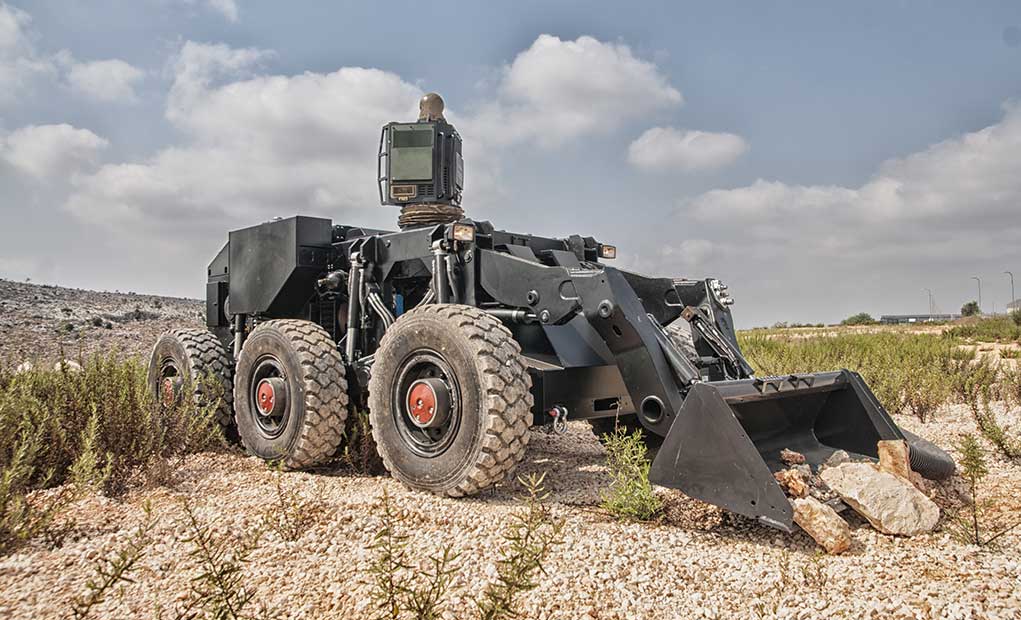With autonomous vehicles rapidly maturing and expected to become part of our daily life in five to ten years, it is only logical that military robotics will follow. But, according to Meir Shabtai, General Manager of Robotic Systems Division at Israel Aerospace Industries (IAI), the military robots are already here now. “The systems are ready, technologies are mature, but the troops have yet to accept them as part of the combat team. Shabtai told Defense-Update. “Military robotics are different from commercial autonomous vehicles as the main requirement is not moving people safely but replace the human in dangerous missions thus reduce the risk to human crewmembers” Shabtai explained.
To earn the soldier’s trust military robots are required to carry loads as quietly and stealthily as a trained soldier. They must operate sensors and weapons effectively under fire and deliver supplies to the front line. They should survive battlefield hardship, defeat enemy attacks and overcome countermeasures. Robots should also be able to do what few or no human soldiers can – deal with explosive devices before they go off; sense and manipulate tools in hazardous environments where humans cannot live.
IAI offers several groups of military robots. The lightest is a small vehicle designed to closely support a squad of warfighters, carry loads and conduct basic combat support tasks, reducing the dependence on dismounted troops for load carrying. Driverless trucks that can follow each other to form an autonomous convoy are used to push logistics to support combat units. IAI also offers semi- or fully autonomous robotic systems based on multirole wheeled or tracked vehicles, that can be configured to assume specific missions utilizing specific mission kits.

Small robotic mules are designed to operate close to the soldiers, but impose minimum burden on management and control, as they follow the soldiers and obey voice commands and gestures. Other, larger combat robots can move autonomously and act as a ‘wingman’ that operate in support of other elements or grouped with few robots that carry out independent missions, such as an advanced guard.
“Each family has specific parameters, but they all share common functions,” Shabtai explained. IAI’s Robotic Kit that addresses those common tasks, transforms every vehicle into an autonomous platform. This robotic kit is a collection of electro-mechanical, electronic hardware assemblies and the software applications required to operate and manage a robotic platform. The kit can be installed on all types of vehicles, including APCs and trucks, and bulldozers, transforming manned vehicles to optionally manned (dual use) or driverless platforms.

Many of the tasks pose significant challenges for developers – autonomous control of a robot in an unknown terrain is not like moving in clearly marked lanes, or teleoperated operation in areas that are familiar to the machines and controllers. Planning a mission, assessing traversability and operating mission sensors become very challenging off-road, and while moving in complex terrain such as mud, sand, deep snow, boulders, shrubs or in an urban or rugged area. Detecting, avoiding and maneuvering around obstacles and terrain features. Affordability is another challenge. “Larger platforms generally offer better mobility, but are more expensive and need expert operators,” Shabtai added. “Our goal at IAI is to bring the performance and usability of those platforms to enable soldiers to operate them with minimal training and expertise.”
“The types of platforms we support address the user need. We know to robotize and automate all vehicle types.” Shabtai said. Tracked and wheeled platforms of different weight and sizes are available to meet those needs. Depending on the type of terrain, mobility independence, and expected obstacles, IAI utilizes platforms as dedicated robotic platforms such as the wheeled Robattle UGV. “We enable the precision of movement, sensor handling and weapon control for robotic platforms to carry out diverse missions and maintain the operational tempo in complex terrain,” Shabtai added.

Robotic War Machines
Combat Unmanned Ground Systems (UGS) represent the next phase in military robotics, introducing platforms that can move and operate sensors autonomously and operate weapons autonomously or under human supervision. They are designed to conduct missions independently, or as part of the tactical formation (company, battalion).
Such vehicles are designed with adequate mobility, power generation, and autonomy to sustain extended missions, and deliver intelligence and firepower to become a viable element in the future combat team.
Successful fielding of robotic systems requires changes of the human side. To fully embrace robotics, soldiers must accept them as trusted teammates. To earn that trust robots should be used extensively in training and embed training capabilities within their operating systems. Such training aids should engage the user by challenging the user with synthetic threats, and obstacles adding realism to exercises. This will help develop troops’ confidence in the robotic system.

Related: IAI Completed a New Route Clearing Robot for Operational Testing
Autonomous Combat Service Support
A different solution addresses the challenge of logistical supply to frontline troops. Today, long convoys of trucks and security vehicles are employed, forcing the military to commit significant forces to secure convoys and schedule resupply operations at long intervals. Employing unmanned trucks operating independently or in convoys of fewer vehicles, that enable more frequent resupplies, and require less escort. The combinations with other manned or unmanned vehicles. In these applications, conventional trucks are equipped with robotic kits, enabling them to travel primarily on roads. Carrying supplies to forward deployed units, without risking drivers, logisticians and security guards.
IAI offers such capabilities as full solutions, and as individual systems meeting specific user needs, maintaining resilient communications, movement and operation in a GPS-denied environment. IAI’s robotic logistics, for example, include the installation of a robotic applique kit on every vehicle, manned or unmanned, to enable users to configure the logistical operations to meet operational requirements. With advanced sensors and smart processors, the kit’s processors run advanced algorithms and artificial intelligence to deliver smarter, more agile operation.
Such convoys should be able to complete their mission in a reliable and safe manner, under all visibility and weather conditions, including day, night, rain, dust, ice, smoke and countermeasures. They must be able to operate with many vehicles and bypass obstacles, without communications and GPS. This will enable the user to move a convoy as fast as possible over friendly and familiar territory but opt to follow a leader or drive autonomously in areas where the vehicles may be exposed to enemy attack. These applique robotic kits are designed to be affordable and easy to install, to enable armies to keep existing vehicle fleets in the future, by introducing optionally manned operation.

Robotic Porters – More than a Mule
Delivering supplies from the forward site to the troops is the task of another class of machines – the robotic mules. Handling this ‘last mile challenge’ requires robotic vehicles that operate autonomously, semi-autonomously or under human supervision, carry loads, and support the troops on extended missions by offloading some of the loads carried by the troops and provide energy for battery recharging. Some can also mount a stretcher to evacuate the wounded back to safety. When equipped with additional sensors, they can provide surveillance and overwatch and securing tactical movements and field deployments.
Such a mule is IAI’s REX, a compact and lightweight 4×4 wheeled platform that can be transported on vehicles or in helicopters, deploy wherever soldiers operate and move with the troops at a speed up to 12 km/h. Rex can carry a payload of 250kg, enough to support a dismounted infantry squad. As the squad’s loads are unpacked, REX can carry a pedestal mounting an electro-optical sensor to continue supporting the unit. The vehicle operates in remote control mode or in ‘follow-me’ mode (‘leashed’ to one of the squad members to follow close behind). These modes require minimal attention and at from the operator. The robotic mule adapts to specific missions by applying mission-specific ‘Jackets’ that configure the REX with different combinations of equipment and weaponry. For example, a logistics jacket comprises a flatbed with hooks and attachments for backpacks, containers, ammunition boxes and stretchers. An intelligence jacket adds an EO payload mounted on a pedestal, and a tripod, control system and energy source to support the sensor on a dismounted operation.
Integrating Air and Ground Robotic Operations
IAI is exploring the enhanced use of robotic systems in combined air-ground operation. “The synergy between the different domain platforms allows us to use the advantages each platform provides delivering a superior whole solution.” Shaul Shahar, IAI EVP and General Manager of IAI’s Military Aircraft Group said. IAI considers such a solution for border patrol, reconnaissance and surveillance operations at remote areas, using hybrid ground and air robotic system. Managed as an integrated solution, the system allows continuous operation under complex and challenging terrain at long range and non-line of sight (NLOS). The system integrates three robotic platforms from IAI – the Robattle UGV, BirdEye 650D Unmanned Aerial Vehicle (UAV) and communications network that establishes NLOS connectivity.
Closely collaborating, Robattle carries sensors such as the Black Granite, that conduct persistent surveillance. It can also mount a remotely operated weapon station to deliver an actionable response. Small drones can be launched from the vehicle to investigate an area of interest while the UGV maintains a position at a defilade, just like a manned scout would. Flying high above the area, the UAV enables an elevated view of the area, provides early warning on enemy activities beyond the land elements’ line of sight and establishes a reliable communications relay linking the command post to the UGV on the ground, even when the vehicles are far beyond the line of sight. On such missions, Robattle can operate autonomously, without resupply, for 72 hours.
















